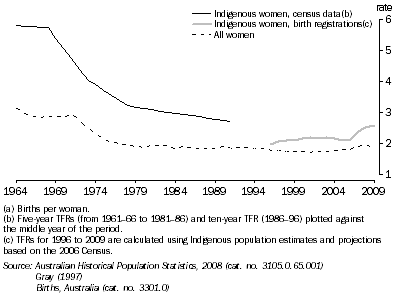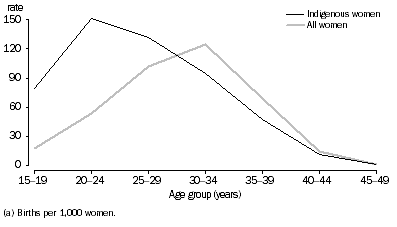TRENDS IN INDIGENOUS FERTILITY RATES
Total fertility rate
Total fertility rates (TFRs) for Aboriginal and Torres Strait Islander women and all women for the period 1964 to 2009 are presented in graph 3.3. Due to the poor quality of historical Aboriginal and Torres Strait Islander Australians birth registrations data, fertility rates for Aboriginal and Torres Strait Islander women up to 1991 were derived using data collected in the Australian censuses (Gray, 1997). With improvements in coverage, birth registrations data have been used for 1996 onwards. Due to the uncertainty in numbers of Aboriginal and Torres Strait Islander births, as well as Aboriginal and Torres Strait Islander population estimates used as denominators in the calculation of fertility rates, data should be interpreted with caution. For more information on Aboriginal and Torres Strait Islander population estimates, see Experimental Estimates and Projections, Aboriginal and Torres Strait Islander Australians, 1991 to 2021 (cat. no. 3238.0).
In the early 1960s, the TFR of Aboriginal and Torres Strait Islander women was 5.8 babies per woman, compared with 3.2 babies for all women in Australia. Since then, fertility rates of both Aboriginal and Torres Strait Islander women and all women have declined substantially, with the largest decreases recorded during the 1970s.
In 1996 the TFR for Aboriginal and Torres Strait Islander women was 1.97 babies per woman, the lowest on record. Over the following decade, the TFR remained at around 2.1 to 2.2 babies per woman. In 2007, the TFR for Aboriginal and Torres Strait Islander women increased to 2.40 babies per woman and has continued to increase reaching 2.57 babies per woman in 2009 (compared with 1.90 for all women in Australia).
3.3 Total fertility rates(a)
, Indigenous and all women - 1964 to 2009

Age-specific fertility rates
High fertility rates at younger ages contribute to the relatively high overall fertility rate of Aboriginal and Torres Strait Islander women compared with all women. Births to women aged under 30 years contributed to over three-quarters (76%) of the total fertility rate of Aboriginal and Torres Strait Islander women in 2009, compared with less than half of the total fertility rate for all women (46%).
3.4 Age-specific fertility rates(a)
, Indigenous and all women - 2009

For Aboriginal and Torres Strait Islander women, the peak age group for births in 2009 was 20-24 years (152 babies per 1,000 women), followed by women aged 25-29 years (132 babies per 1,000 women). The fertility rate for Aboriginal and Torres Strait Islander women aged 20-24 years was close to three times the fertility rate of all women in this age group (54 babies per 1,000 women). In contrast, the peak age group for all women in 2009 was 30-34 years (124 babies per 1,000 women), with higher fertility rates for all women aged 30 years and over than those for Aboriginal and Torres Strait Islander women.
Teenage fertility rates
In 2009, births to teenage Aboriginal and Torres Strait Islander women (2,400 births) accounted for 21% of all births to Aboriginal and Torres Strait Islander women (11,500 births). In comparison, births to all teenage women accounted for only 4% of all births. Overall, the teenage fertility rate of Aboriginal and Torres Strait Islander women (79 babies per 1,000 women) was almost five times the teenage fertility rate of all women (17 babies per 1,000 women).
 Print Page
Print Page
 Print All
Print All